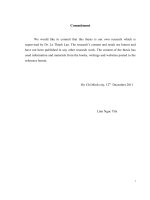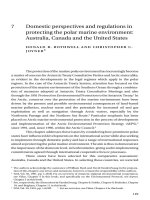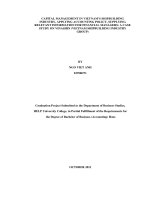developing domestic suppliers of electronics in vietnam the case study of canon vietnam’s strategy
Bạn đang xem bản rút gọn của tài liệu. Xem và tải ngay bản đầy đủ của tài liệu tại đây (1.15 MB, 185 trang )
i
DEVELOPING DOMESTIC SUPPLIERS OF ELECTRONICS
IN VIETNAM: THE CASE STUDY OF
CANON VIETNAM’S STRATEGY
A Dissertation
Submitted to the Faculty of the
Graduate Studies in Business Southern Luzon State University
Lucban, Quezon, The Philippines in Collaboration with
Thainguyen University, Socialist Republic of Vietnam
In Partial Fulfillment
of the Requirements for the Degree of
Doctor in Business Administration
Name : Tran Xuan Ngoc
English Name : Ronaldo
Date of Birth : 30/03/1975
Hanoi – 2013
ii
iii
ACKNOWLEDGMENT
Firstly, I am particularly grateful to my dissertation committee: Dr. Cecilia N.
Gascon, Prof. Nordelina B. Ilano, Dr. Walberto A. Macaraan, Dr. Joanna Paula A.
Ellaga, Dr. Nelly I. Mendoza, and Special thanks to my advisor Dr.Eduardo T.Bagtang,
It is only with their precious assistance, support and guidance that I was able to fulfill
my dissertation. They shared valuable time from their busy schedules to help and give
me critical comments and suggestions.
I gratefully acknowledge Southern Luzon State University, Thai Nguyen
University, Thai Nguyen University of Agriculture and Forestry, International School -
Thai Nguyen University, International Training Center of Thai Nguyen University of
Agriculture and Forestry, and the staff. I have greatly benefited from good study
facilities, materials, and dynamic academic environment.
I want to express my deep gratitude to Hanoi People's committee, Hanoi
Vocational College of High Technology who has supported to study.
I am greatly indebted to researchers and all my colleagues who have helped me
to overcome many difficulties during the past hard time. They shared their views and
insights on the dissertation as well.
Finally, I wish to thank my family members for their spiritual encouragement and
material support. Thank others who did not participate directly but their works have been
essential to the success of my dissertation.
iv
ABSTRACT
RESEAQRCHER : TRAN XUAN NGOC
TITLE : Developing Domestic Suppliers of Electronics in Vietnam: The
case study of Canon Vietnam’s strategy.
SCHOOL : Southern Luzon State University, Lucban, Quezon
COURSE : Doctor in Business Administration
YEAR : September, 2013
ADVISER : Dr. EDUARDO T.BAGTANG
The general objective of this research is to find out the theoretical reasons and
practical evidence proving that the subsidiaries company (Canon Vietnam) can influence
on the development of local suppliers’ capacity in order to promote the competitive
advantages and expand production. This study focuses on the following specific
contents: 1. Profile of the subsidiaries; 2. Autonomy of the Subsidiaries; 3. Knowledge
transfer strategies; 4. Competitive advantages of the subsidiaries in Vietnam that can
help develop local suppliers; 5. Government policies towards developing local or
domestic suppliers’ capabilities.
The main method employed in the dissertation research is case study, one of
important ways of doing research in social sciences (Yin, 1994; Eckstein, 2000; Strauss
and Corbin, 1998). The documentary analysis and the questionnaire were the main
instruments used in data gathering. 250 sets of questionnaires were distributed to the (6)
managers of Cannon Vietnam and to the (100) employees of Cannon Vietnam and to the
(4) managers of the local suppliers and (140) employees of the local suppliers of Cannon
in Vietnam. Our research also employs archival and general data of electronic
v
manufacturing industry in Vietnam. The data was gathered from Ministry of Industry,
Ministry of Finance, Ministry of Trade, and Ministry of Public Security. Additional data
were obtained from written materials such as publications, documents, and business
press articles appeared in the mass media.
Researcher use SPSS program to process the data analysis. By statistical
methods, the authors draw conclusions about the key factors affecting the development
of local suppliers’ capacity: Local Strategies of multinational companies; These
competitive advantages of multinational companies in local environment, knowledge
transfer, knowledge transfer methods; capacity of suppliers; ability of suppliers to meet
the demand and policy of the government;
The regression model was checked for errors. After performing the data
processing method, the models are proved to be reliable and be able to explain the
dependent variable based on the independent variables.
After analyzing the data using regression models, the conclusions are generated
on the obtained results. On the basis of these results and conclusions, the authors make
recommendations in order to develop the manufacturing sector, which provides
electronic products in the country.
vi
TABLE OF CONTENTS
Page
TITLE PAGE. . . . . . . . . . . . . . . . . . . . . . . . . . . . . . . . . . . . . . . . . . . . . . . . . . . i
APPROVAL SHEET. . . . . . . . . . . . . . . . . . . . . . . . . . . . . . . . . . . . . . . . . . . . . ii
ACKNOWLEDGMENT . . . . . . . . . . . . . . . . . . . . . . . . . . . . . . . . . . . . . . . . . . iii
ABSTRACT . . . . . . . . . . . . . . . . . . . . . . . . . . . . . . . . . . . . . . . . . . . . . . . . . . . iv
TABLE OF CONTENTS . . . . . . . . . . . . . . . . . . . . . . . . . . . . . . . . . . . . . . . . . vi
LIST OF TABLES . . . . . . . . . . . . . . . . . . . . . . . . . . . . . . . . . . . . . . . . . . . . . . xi
LIST OF FIGURES. . . . . . . . . . . . . . . . . . . . . . . . . . . . . . . . . . . . . . . . . . . . . . xiv
LIST OF APPENDIXES. . . . . . . . . . . . . . . . . . . . . . . . . . . . . . . . . . . . . . . . . . xv
vii
CHAPTER I: INTRODUCTION
1
1.1. Background of the Study 1
1.2. Statement of the Problem 3
1.3. Objectives of the Study 5
1.4. Hypotheses of the Study 6
1.5. Significance of the Study 7
1.6. Scope and Limitations of the Study 8
1.7. Abbreviations 10
1.8. Definition of term 11
CHAPTER II: REVIEW OF RELATED LITERATURE AND STUDIES . 15
2.1. Subsidiary in local environment 15
2.1.1. The development process of subsidiaries 15
2.1.2. The effects of local environment on the development of
subsidiaries
17
2.2. Local Suppliers of Electronics 22
2.2.1. Some arguments about Supplier Industries 22
2.2.1.1. Supplier Industries 22
2.2.1.2. Suppliers 27
2.2.1.3. Factors affecting the development of Suppliers 27
2.2.2 Suppliers of electronics products 30
2.2.2.1. Technology process to produce electronic products 30
2.2.2.2. The electronics supporting industry in Vietnam 31
2.2.2.3. Vietnam’s electronics suppliers 35
2.2.2.4. Affecting factors of Suppliers of electronics products 39
viii
2.3.International experience in developing Local Suppliers 40
2.3.1. Development policies of Local Suppliers 40
2.3.2. Regulation onlocalization 42
2.3.3. Foreign investment attraction 43
2.4. Conclusion 45
2.4.1. From the government 45
2.4.2. From the local suppliers 46
2.5. Conceptual Framework 46
CHAPTER III: METHODOLOGY
48
3.1. Research Design 48
3.2. Determination of sample size 52
3.3. Sampling design and techniques 53
3.4. Subject of the study 53
3.5. Research instrument 53
3.6. Data processing method 54
3.7. Statistical treatment 54
CHAPTER IV: PRESENTATION, ANALYSIS, AND INTERPRETATION
OF RESULTS
59
4.1. Subsidiary company’s profile 59
4.1.1. Company culture 59
4.1.2. Organizational Structure 61
4.1.3. Operation Scale 64
4.1.4. Operation duration at the local 65
4.1.5. Number of local suppliers 66
4.1.6. Assessment of the Subsidiary Profile that Affects the Capacity 68
ix
Development of the Local Electronics Suppliers
4.2. Autonomy of Subsidiary Company 70
4.2.1. R&D 70
4.2.2. Financial Management. 71
4.2.3. Marketing Strategy 73
4.2.4. Production Strategy 74
4.2.5. Production Process. 75
4.2.6. Supplier Selection. . . 76
4.2.7. Assessment of the Subsidiary’s Autonomy that Affects the
Capacity Development of the Local Electronics Supplier
79
4.3. Knowledge transfer from Subsidiary company to local suppliers 81
4.3.1. Absorptive capacity 85
4.3.2. Responsiveness 88
4.3.3. "Hands-on" approach to transfer knowledge 98
4.3.4.Assessment of the Knowledge transfer from Subsidiary that Affects
the Capacity Development of the Local Electronics Suppliers
104
4.4. Competitive Advantages of Subsidiary Company 106
4.4.1. Production Capacity 107
4.4.2. Capacity of Design and Renewing 110
4.4.3. Technology of production 112
4.4.4 Quality of Management 113
4.4.5. Price policy of Canon Vietnam 116
4.4.6. Assessment of the Subsidiary’s Competitive Advantages that
Affects the Capacity Development of the Local Electronics Suppliers
117
4.5. Government Policies 119
x
4.5.1. Protection of domestic production 120
4.5.2. Priority to electronics industry 121
4.5.3. Central Management Unit 121
4.5.4. Set up standards of quality and components 122
4.5.5. Reducing the gap between policies and implementation 123
4.5.6. Assessment of the Government Policies that Affects the Capacity
Development of the Local Electronics Suppliers
123
4.6. Analysis and Interpretation of Data 125
4.6.1. Assessment of the scale's reliability 125
4.6.2. Test the distribution format of the scales 128
4.6.3. Hypothesis Testing 130
4.6.4. Analysis of affecting factors 133
CHAPTER V: SUMMARY, CONCLUSIONS, AND
RECOMMENDATIONS
139
5.1. Summary 139
5.2. Conclusions 140
5.3. Recommendations 141
5.3.1. Recommendations for Businesses 141
5.3.2. Recommendations about the management agency 146
BIBLIOGRAPHY
151
APPENDIXES
160
xi
LIST OF TABLES
Table
Page
1 SWOT Analysis for the electronics industry of Vietnam 32
2
The situation of the electronics industry and its supplier
industries in ASEAN countries
44
3 Summary of case studies 49
4 Variables 52
5 Factor loading 55
6 Number of local suppliers 68
7
Assessment of the Subsidiary Profile by the Canon
Managers and the Local Electronic Supplier Managers 68
8
Assessment of the Subsidiary Profile by the Canon
Vietnam Employees and the Local Electronic Suppliers’
Employees
69
9
Assessment of the Subsidiary’s Autonomy by the Canon
Managers and the Local Electronic Supplier Managers
79
10
Assessment of the Subsidiary’s Autonomy by the Canon
Vietnam Employees and the Local Electronic Suppliers’
Employees
80
11
Transferred knowledge between Canon and local
suppliers
99
12
Assessment of the Knowledge transfer by the Canon
Managers and the Local Electronic Supplier Managers
105
xii
13
Assessment of the Knowledge transfer by the Canon
Vietnam Employees and the Local Electronic Suppliers’
Employees
105
14
Assessment of the Competitive Advantages by the Canon
Managers and the Local Electronic Supplier Managers
117
15
Assessment of the Competitive Advantages by the Canon
Vietnam Employees and the Local Electronic Suppliers’
Employees
118
16 Localization of Canon’s electronics 119
17
Assessment of the Government Policies by the Canon
Managers and the Local Electronic Supplier Managers
124
18
Assessment of the Government Policies by the Canon
Vietnam Employees and the Local Electronic Suppliers’
Employees
124
19
Reliability of the independent variable: Company’s
profile - CP
126
20
Reliability of the independent variable: Autonomy of
Company - AC
126
21
Reliability of the independent variable: Knowledge
Transfer - KT
126
22
Reliability of the independent variable: Competitive
Advantages - CA
127
xiii
23
Reliability of the independent variable: Government
Policies – GP
127
24
The reliability of the control variable: Capability
Development of Local Suppliers – DCLS
128
25 Statistical description of the scales 129
26 ANOVA (Testing differences between the study groups) 131
27 Correlations 131
28 Variables Entered/Removed 134
29 Model Summary 135
30 ANOVA
e
135
31 Coefficients
a
136
xiv
LIST OF FIGURES
Figure
Page
1 Porter’s Diamond 18
2 “Supplier industries” Concept of Japan 24
3 “Players” network of the “Game Theory” 27
4 “Players” Network in supplier industries 28
5
Expanded “Players” Network in Supplier Industries in a
country 28
6 Production Process of Electronic Products 31
7
Export value of Vietnam’s electronics components and
computer units 36
8
Vietnam’s import value of electronic components,
electronic and computer items 38
9 Conceptual Paradigm 47
10 Performance Results of Canon Vietnam 65
11 Characteristic of local suppliers 97
12 Environment change and Canon response 107
13 Definition of supporting industries 111
xv
LIST OF APPENDIXES
Appendix
Page
A Canon’s evaluation on supplier capabilities 159
B Characteristics of newly established enterprises 160
C Canon Vietnam Organization 161
D Questionnaire for Canon 162
E Questionnaire for Suppliers 165
F Curriculum vitae 168
1
CHAPTER I
INTRODUCTION
1.1. Background of the Study
After 25 years of reform, Vietnam's economy has grown stronger and integrated
deeper into regional as well as global economies. A number of industries have
experienced the fast growing; there are also the first Vietnam businesses involved in the
supply chain of the global value. Vietnam has become an emerging market that is very
attractive to international investors and economic researchers.
Practice has proved that the emerging markets could bring the businesses the most
important investment opportunities and growth. The emerging markets are the place to
test the concept, model, and existing theories. At the same time it also creates
opportunities for researching and developing the new theories in the field of business
administration.
Among the emerging markets, Vietnam is an obvious example of the great and
profound changes in attracting foreign investment to develop domestic industry. However,
the industrialization of Vietnam today is facing a huge challenge: we must carry it out
under the conditions of trading liberalization with other countries all over the world.
Meanwhile, the competitiveness of Vietnamese industrial products in general is weak,
especially those manufacturing machinery, equipment’s, components and materials. We
could say that the most basic weakness of Vietnam's industry stems from the weakness of
the supporting industries. This involves the "survival" of the Vietnam industry, closely
associated with the issue that whether the economy of Vietnam can be internationally
competitive enough to develop or not. On the other hand, that the weakness of
fundamental facility have contributed to the deficit of trading balance in Vietnam.
2
Because we have to import a lot of components, raw materials for export production so
that the more we boost the exports, the faster the demand for inputs increase, which
causes the trade deficit surged
Currently, the development of the domestic market fraught with spontaneity, lack
of sustainability. Local businesses are numerous yet not strong, the majority belongs to
the types of small and medium businesses, which are few, backward, under a poor
condition of fundamental and technical facility, lacking developing strategy, capacity and
of weak position. The implementation of regional and international commitments of VN is
still passive, Quite a few of businesses is now still expecting an extension of protectorate;
The slow application of international standards in the production and trade has caused
some businesses VN difficulties when joining the production cycle in the local market.
In the manufacturing industry, Electronics industry is highly representative for a
developing country with a large population as Vietnam. In the context of scientific and
technological progress and globalization today, the situation of developing electronics
industry in Vietnam has revealed a number of problems. On the domestic market, the
supply businesses in Vietnam are of much weaker position than firms with foreign capital
investment. On the other hand, the electronic products of Vietnam are put under a huge
competitive pressure of China. In terms of the value chain, the electronics industry of
Vietnam mainly assembles consumer products, focusing on the stages with low added
value. Very few companies produce detailed parts and accessories in electronics. Foreign
investors in this sector are mainly export-oriented, not oriented to promote connectivity
supporting industries in the country to create a shift in the value chain. This limits the
ability to develop this sector and limit the impact of technology transfers as well as
scalability to attract FDI. The assembling phase is mainly toward cheap labor, but this is
not possible advantage to gain a long-term health.
3
Finding out the solution to promote the development of the domestic suppliers is
the major concern of many managers and economic researchers. In order to specify and
realize the study content, the subject is limited to the domestic supply of Electronics, as a
typical study case.
In the context of a group of electronics manufacturers closed their plants in
Vietnam, Canon Vietnam is a different case. For over 10 years, Canon Vietnam has been
continuously expanded their production, especially effectively building a network of local
suppliers.
The topic of "Developing Domestic Suppliers of Electronics in Vietnam: The
case study of Canon Vietnam’s strategy" is meaningful and useful for managers of multi-
national companies in electronic field when considering invest or now operating in
Vietnam, the firms who are now providing electronic domestic products the Vietnam
Policymakers.
1.2. Statement of the Problem
The recent state of electronics industry in Vietnam revealed problems of
competition of local suppliers with foreign suppliers. Local suppliers of Vietnam are
much weaker when compared to the foreign suppliers.
Foreign investors import most of the components of the electronic products;
hence, the local suppliers can no longer compete with them even with their cheap labor.
This situation limits the development of electronic industry in Vietnam.
To make the local suppliers of Vietnam competitive there is a need therefore to
develop their capabilities.
This study aim of the following objectives:
1. Identify the existing condition and operation of Canon Company in Vietnam in term of:
4
1.1. Company culture
1.2. Organizational Structure
1.3. Operation Scale
1.4. Operation duration at the local
1.5. Number of local suppliers
2. Find out the extent of autonomy of Canon Subsidiary in term of:
2.1. R&D
2.2. Financial Management
2.3. Marketing Strategy
2.4. Production Strategy
2.5. Production Process
2.6. Supplier Selection
3. Determine the extent of knowledge transfer from Subsidiary company to local supplier
in term of:
3.1. Absorptive capacity
3.2. Responsiveness
3.3. "Hands-on" approach to transfer knowledge
4. Identify the Competitive Advantages of Subsidiary Company that can help develop
local suppliers in term of:
4.1. Production Capacity
4.2. Capacity of Design and Renewing
4.3. Technology of production
4.4. Qualifications of Management
4.5. Price policy
5
5. Find out the extent of Government policies towards developing local or domestic
suppliers’ capabilities in term of:
5.1. Protection of domestic production (import tax…)
5.2. Priority to electronics industry (incentives, production tax…)
5.3. Central Management Unit
5.4. Set up standards of quality and components
5.5. Reducing the gap between policies and implementation
1.3. Objectives of the Study
The overall objective of the study is to determine factors that can help develop the
capabilities of local or domestic suppliers in Vietnam. Specifically, the study aimed to
determine the current operation of Canon Vietnam following objectives:
1. To determine the profile of the Canon Vietnam in terms of the following:
1.1. Company culture
1.2. Organizational Structure
1.3. Operation Scale
1.4. Operation duration at the local
1.5. Number of local suppliers
2. To determine the extent of autonomy of Canon Vietnam in terms of the following:
2.1. R&D
2.2. Financial Management
2.3. Marketing Strategy
2.4. Production Strategy
2.5. Production Process
2.6. Supplier Selection
6
3. To determine the Knowledge transfer from Subsidiary company to local suppliers in
terms of:
3.1. Absorptive capacity
3.2. Responsiveness
3.3. "Hands-on" approach to transfer knowledge
4. To determine the competitive advantages of the canon subsidiaries that can help
develop local suppliers?
4.1. Production Capacity
4.2. Capacity of Design and Renewing
4.3. Technology of production
4.4. Qualifications of Management
4.5. Price policy
5. To identify the Government policies towards developing local or domestic suppliers’
capabilities?
5.1. Protection of domestic production (import tax…)
5.2. Priority to electronics industry (incentives, production tax…)
5.3. Central Management Unit
5.4. Set up standards of quality and components
5.5. Reducing the gap between policies and implementation
1.4. Hypotheses of the Study
This study aim to test the following hypotheses:
H1. There is significant difference in the perception of the managers of the CVN
managers, employees and managers, employees of the local or domestic suppliers.
7
H2. There is significant relationship of the Profile of the Subsidiaries to the
development capability of the local domestic suppliers.
H3. There is significant relationship of the Autonomy of the subsidiaries to the
development capability of the local domestic suppliers.
H4. There is significant relationship of the Knowledge transfer of the Subsidiaries
to the development capability of the local domestic suppliers.
H5. There is significant relationship of the Competitive Advantage of the
Subsidiaries to the development capability of the local domestic suppliers.
H6. There is significant relationship of the Government Policies of the
Subsidiaries to the development capability of the local domestic suppliers.
1.5. Significance of the Study
Basically, multinational companies competing on the international market have to
deal with the changes of the local environment. Effective response with appropriate
strategies and policies will give the companies an advantage over the competitors. They
can build up capacity when combining with domestic suppliers. Building an efficient
network of domestic suppliers by transferring technology, developing existing
relationships, helping these suppliers involve in the value chain, improving the key
elements of local environment will help multinational companies promote their strength.
This is important for leaders to review and adjust the orientation of the company.
At the national level, this study has an important meaning for policy makers to
understand the behavior of multinational companies when they invest in the host country.
The government policy should be adjusted to improve the local business environment,
encourage contributions from multinational corporations, not to hinder their opportunities,
create conditions for all the factors in market to develop.
8
In fact, the industrial development policies of Vietnam government are usually
considered in a wide range of various types of electronic companies. The role of
multinational ones is underestimated. Focusing on Canon Vietnam, this study will explore
the role of a large company in accelerating the development of domestic suppliers. The
major direction of such companies affects the entire electronics industry.
The results of this study will help domestic suppliers determine needs of
multinational companies, adjust their operation strategy, improve capacity and
competitiveness.
This study will be the important reference source for local supporting industries.
Basically, they benefit a lot from this study.
Students and researchers can use this study as reference for future studies.
1.6. Scope and Limitations of the Study
This study focuses on domestic suppliers and supporting industry companies in the
industry of electronics. For that reason, the study pays more attention to the local strategy
of the company rather than to global or regional ones. However, some regional impacts
are also included in the study. Canon Vietnam is the main subject of analysis. The
development of Canon Vietnam is considered a result of the cooperation between
outsourcing and domestic suppliers and is accumulated during the operation in Vietnam.
Local environment includes the main elements: suppliers, competitors, consumers
and government policies. The relationship between company and the elements plays a
central role in this study. It includes changes and impacts of the elements, reactions and
behavior of the company. Among the elements, suppliers are particularly emphasized
when transferring knowledge between assemblers and domestic suppliers in Vietnam.
9
Firstly, the study focuses on only a successful case in developing domestic
suppliers. It would make more sense if the study included a larger sample of other foreign
companies in the industry. Secondly, the electronics industry has a very large market.
Huge foreign enterprises enter the market to invest in products, semi-products to meet the
demands of domestic and global market. Therefore, some phenomenon in this study
cannot be generalized to apply on other industries.
10
1.7. Abbreviations
CBU Complete Build Up
CKD Complete Knock Down
CVN Canon Vietnam Company
FDI Foreign Direct Investment
GDP Gross Domestic Product
IKD Incomplete Knock Down
ISO International Standard Organization
MNC Multinational Corporation
MOF Ministry of Finance
MOI Ministry of Industry
MOT Ministry of Trade
MPI Ministry of Planning and Investment
NEU National Economic University
ODA Official Development Assistance
PDM Product data management
QAV Quality Assurance Visit
R&D Research and Development
SMC Supply chain management
USD United States Dollar
VDF Vietnam Development Forum
VND Vietnam Dong
WTO World Trade Organization









